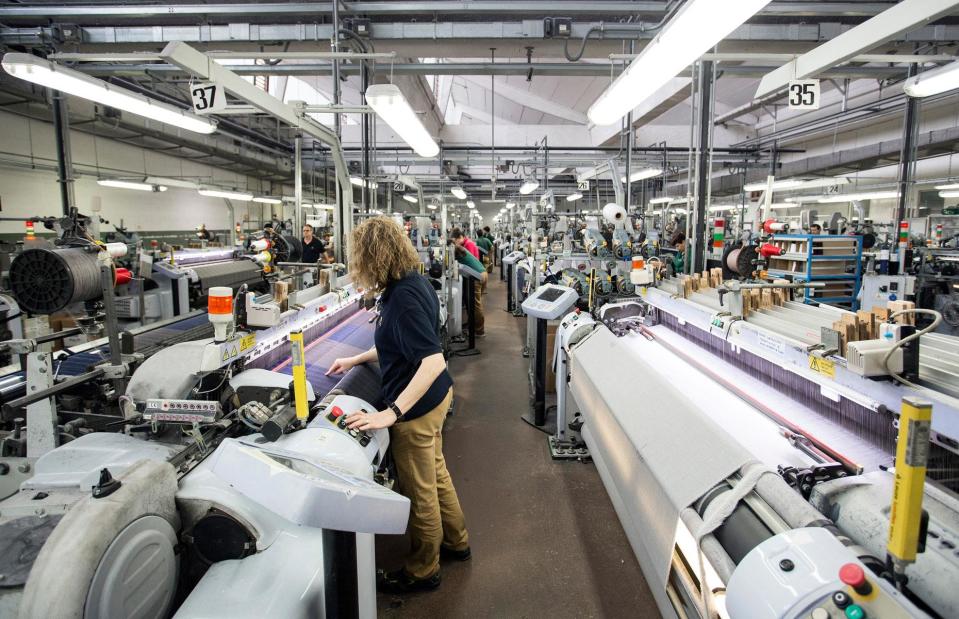Where does the UK rank among the world's most productive countries?
Discover the global powerhouses

Leonhard Simon/Getty Images
Experts are heralding a reboot of the economic prosperity of the Roaring Twenties, with productivity growing in the US and many other nations.
This is partly thanks to artificial intelligence (AI), advanced robotics, and other technological breakthroughs. However, there are still plenty of countries where productivity growth has slowed, with little to no indication that it will be picking up again anytime soon.
With this in mind, read on to discover the world's 30 most productive nations and their vastly differing growth prospects for 2024, based on data from the International Labour Organization (ILO).
The ILOSTAT data

GaudiLab/Shutterstock
ILOSTAT, the ILO's labour statistics portal, calculates the productivity of a country as its GDP-per-hour-worked. Effectively, it's a measure of the average output generated per 60 minutes of work.
For consistency, ILOSTAT measures each country's productivity in constant 2017 purchasing power parity (PPP) US dollars.
The world's least productive countries

R. Bociaga/Shutterstock
Based on 2023 figures, the world's least productive countries are Burundi, the Central African Republic, and Liberia. Their GDPs-per-hour-worked amount to just one US dollar each, which is hardly surprising given that the economies of these undeveloped, impoverished African countries are largely based on subsistence farming.
Interestingly, mainland China's productivity is also low. Last year, its GDP-per-hour-worked came in at only $15, the same as war-torn Ukraine's, which is Europe's worst performer for obvious reasons. And India's figure is even lower, at just $8.
Joint 29. New Zealand, GDP-per-hour-worked in 2023: $46

Lakeview Images/Shutterstock
New Zealand's productivity is among the worst in the OECD, as highlighted by a 2023 report from the country's Productivity Commission.
Last year, Aotearoa's GDP-per-hour-worked came in at a disappointing $46, while productivity growth was even more dismal at -0.6%. And while the predicted figure for 2024 is moderately better at 1.1%, it's still nothing to brag about.
Prime Minister Christopher Luxon has bemoaned the nation's "productivity disease", which it has struggled with since the 1970s. The long-term problem has been put down to a range of factors, from a chronic lack of research and development (R&D) spending to a relatively poorly skilled workforce, as well as the country's isolation from major markets.
Joint 29. Czech Republic, GDP-per-hour-worked in 2023: $46

VIZ UALNI/Shutterstock
GDP-per-hour-worked also stood at $46 in the Czech Republic in 2023. Productivity growth was a big fat zero and is expected to reach an uninspiring 1% this year.
The country has one of the lowest rates of unemployment in the world. Though this is a positive indicator in many respects, almost-full employment doesn't bode well for productivity growth as it implies the economy is already operating at its maximum potential.
Extremely low unemployment can also deter foreign investment, as investors may assume they'll be unable to source talent and fill job openings.
Joint 29. Lithuania, GDP-per-hour-worked in 2023: $46

Anton Gvozdikov/Shutterstock
Lithuania's GDP-per-hour-worked also amounted to $46 last year – but compared to New Zealand and the Czech Republic, the Baltic state's growth prospects are considerably more healthy.
The growth figure was 1.7% in 2023 and it forecast to climb to 3.4% this year. This could be attributed to increased levels of investment in the wider economy, as well as its looser, more flexible labour market (as opposed to that of the Czech Republic).
28. Slovenia, GDP-per-hour-worked in 2023: $48

BearFotos/Shutterstock
Slovenia's GDP-per-hour-worked was $48 last year, while productivity growth equated to a decent 2% – though it's expected to drop to 1.7% in 2024.
The figure, albeit fairly robust, is still below the pre-pandemic levels of 2019, when it was 3.7%. Among the reasons for this is the fact the country's high rate of wage growth is outpacing productivity gains and making the economy less competitive.
27. Brunei, GDP-per-hour-worked in 2023: $49

Xmentoys/Shutterstock
A wealthy country thanks to its bountiful reserves of oil and natural gas, Brunei's GDP-per-hour-worked is the second-highest in Southeast Asia, coming in at $49 last year.
That said, productivity growth was -1.8% in 2023, which is below its pre-pandemic figure of 2.2%, despite the country ranking in the top 10 for the world's longest working hours.
Still, productivity is predicted to pick up again this year, with a growth of 2.7% anticipated.
26. Malta, GDP-per-hour-worked in 2023: $51

voronaman/Shutterstock
Malta's GDP-per-hour-worked in 2023 is calculated at $51, which is below the EU average. The rate of productivity growth, which has a tendency to fluctuate year by year, was 1% last year and is predicted to increase to 1.9% in 2024. This is still short of the pre-pandemic figure of 2.4% in 2019.
Financial services and iGaming are among the nation's most productive sectors, according to KPMG. These high-value areas could be instrumental in improving Malta's productivity, which could be achieved through increased investment and improvements in education.
Joint 24. Qatar, GDP-per-hour-worked in 2023: $53

SURAJ-X/Shutterstock
Last year, GDP-per-hour-worked in Qatar came in at $53. Productivity growth was recorded at 1.2% and is expected to fall fractionally to 1.1% in 2024.
The country's government has put productivity growth at the crux of its National Development Strategy (NDS3) for 2024-2030, with a view to increasing the annual growth figure to 2%.
As it has done in the past, Qatar will no doubt have to rely on foreign workers to achieve this, as it has the lowest unemployment rate in the world. The nation, which is rich in both oil and natural gas, works the longest hours out of the countries covered in our round-up, presenting a further challenge to productivity growth.
Joint 24. Saudi Arabia, GDP-per-hour-worked in 2023: $53

JOKE_PHATRAPONG/Shutterstock
At $53, the GDP-per-hour-worked of Qatar's neighbour Saudi Arabia was identical in 2023.
The affluent petrostate saw its productivity growth slip to -1.7% last year. But it's not all bad: it recorded the highest figure in the G20 in 2022 and is set for growth of 2.3% in 2024.
Driving this growth are the massive investments the Saudi government is making to diversify the kingdom's economy, which, according to analysis by Goldman Sachs, is forecast to reach one trillion US dollars by 2030.
Joint 20. Spain, GDP-per-hour-worked in 2023: $57

Basilico Studio Stock/Shutterstock
Spain's GDP-per-hour-worked was $57 in 2023, with productivity growth of 1.1%. The figure is predicted to rise to 1.6% this year.
While Spain's productivity growth isn't exactly appalling, the country still has "a lot of scope for improvement". That's according to a 2023 research article from CaixaBank, which quotes a study from the Bank of Spain that underlines the lower levels of education among the workforce (as well as training undertaken by Spanish workers and entrepreneurs) compared to their European counterparts.
Other issues include the relative scarcity of larger companies in the country, which tend to be more productive.
Joint 20. Canada, GDP-per-hour-worked in 2023: $57

Helioscribe/Shutterstock
GDP-per-hour-worked also stood at $57 in Canada last year, while productivity growth was a mere 0.1%. In 2024, the growth figure is forecast to come in at just 0.6%.
Comparatively poor productivity has long plagued the Canadian economy. The Bank of Canada recently described the situation as "an emergency" and has called for urgent private sector investment.
In addition to meagre levels of investment, the experts claim that a lack of competition and a failure to tap into the skill sets of migrants are the major issues holding back productivity.
Joint 20. Taiwan, GDP-per-hour-worked in 2023: $57

Gorodenkoff/Shutterstock
Last year, Taiwan's GDP-per-hour-worked was also $57. Its productivity growth came in at a not-so-great 1.1%, though this is expected to rise to 3.4% in 2024.
In fact, the growth rate is poised to eclipse the country's pre-pandemic figure of 2.4%, which could have a lot to do with its role as the number one global supplier of AI semiconductors and other crucial chips. Needless to say, business is positively booming and the industry is becoming ever more efficient.
Joint 20. Israel, GDP-per-hour-worked in 2023: $57

Michael Thomas/Alamy
Israel's GDP-per-hour-worked stood at $57, putting the country on a par with Spain, Canada, and Taiwan.
Productivity growth was just 1% and is modelled at 1.3% for 2024 according to ILOSTAT, although it's unclear whether this figure was calculated before or after the country's war with Hamas began.
The conflict is taking a punishing toll on Israel's economy and productivity growth is likely to slow, say experts at research organisation RAND.
19. Iceland, GDP-per-hour-worked in 2023: $58

Alexander Gafarro/Shutterstock
Last year, Iceland's GDP-per-hour-worked was $58, with a productivity growth rate of 1.5%. A figure of 1.3% is expected for 2024.
Interestingly, Iceland has embraced a four-day work week with gusto. Trials conducted between 2015 and 2019 were "an overwhelming success", with reports showing that productivity had even improved, despite the workforce putting in fewer hours.
Joint 17. Australia, GDP-per-hour-worked in 2023: $59

Tint Media/Shutterstock
Australia's GDP-per-hour-worked amounted to $59 in 2023, with productivity growth now a major cause for concern in the country. Last year, the figure was a dire 0.1%, with growth of only 0.4% anticipated for 2024.
The productivity of Aussie workers "has fallen off a cliff" according to a piece published by The Guardian last summer. The reasons aren't clear, although some economists have blamed a lack of business competition in the country.
Joint 17. UK, GDP-per-hour-worked in 2023: $59

William Barton/Shutterstock
The UK's GDP-per-hour-worked was identical to Australia's in 2023, with the nation also suffering from similarly lacklustre productivity growth. Last year, the figure stood at just 0.2%, and growth is forecast at a modest 0.6% for 2024.
According to the London School of Economics and Political Science, chronic underinvestment in capital and skills is largely to blame, with government (as opposed to private sector) inaction "particularly concerning".
Other factors cited by experts include a lack of joined-up policies, Brexit-induced business obstacles, political instability, inconsistent educational outcomes, and an ever-widening skills gaps.
16. Italy, GDP-per-hour-worked in 2023: $62

Alessia Pierdomenico/Shutterstock
Last year, Italy's GDP=per-hour-worked was $62. Productivity growth was in the red at -1.1%, although it's expected to recover to a so-so 1.3% in 2024.
Italy's productivity growth has stagnated in recent decades for a whole host of reasons, with the south lagging far behind the north of the country. Moreover, the nation's rapidly ageing population doesn't bode well for its future productivity growth prospects.
Joint 14. France, GDP-per-hour-worked in 2023: $68

Paul Quayle/Alamy
France's GDP-per-hour-worked was $68 last year, which is above the EU average. On the downside, productivity growth, which has been weak for the past two decades, was a miniscule 0.1% in 2023 and is predicted to be just 1.1% this year.
But why? A 2022 study by advisors to the French prime minister pointed to a marked fall in education levels among the French workforce, particularly in terms of maths, as well as issues with tax incentive schemes supporting R&D.
Joint 14. Germany, GDP-per-hour-worked in 2023: $68

Leonhard Simon/Getty Images
Germany matched its neighbour France when it came to GDP-per-hour-worked in 2023. Last year, the country saw a contraction in GDP and its productivity growth was -1.1%, though it's forecast to rebound to a respectable 1.9% in 2024.
The government is seeking to boost productivity by introducing a major four-day work week trial. Another move that could lift productivity growth is the widespread adoption of generative AI, which, according to McKinsey & Company, could lead to an average increase in annual productivity growth of 3.4%.
13. Finland, GDP-per-hour-worked in 2023: $69

alexkich/Shutterstock
GDP-per-hour-worked was $69 in Finland last year. During the same period, productivity growth was -0.6%, although this figure is predicted to return to positive territory (0.9%) in 2024.
The Nordic nation has struggled with poor productivity growth for the past 15 years, which the bank Nordea puts down to insufficient investment in both education and R&D.
On the bright side, the technological disruption that's characterising the 2020s could make all the difference to the country's productivity growth prospects.
Joint 10. USA, GDP-per-hour-worked in 2023: $70

AlessandroBiascioli/Alamy
America's GDP-per-hour-worked stood at $70 in 2023, with productivity growth at 0.7%. It's set to increase in quite a major way this year, with a figure of 2.1% anticipated.
Numerous experts predict the US is on the verge of a productivity boom, with some even suggesting that it's already started. In any case, America is storming ahead of Europe thanks to increased investment and advances in AI, advanced robotics, and other modern technologies.
Joint 10. Guyana, GDP-per-hour-worked in 2023: $70

MJPhotography/Alamy
The fastest-growing economy on the planet, Guyana has seen an astonishing increase in its GDP-per-hour-worked. In 2023, it grew to become on a par with America's, with phenomenal productivity growth of 32.3%. And this year, a figure of 23.3% is forecast.
This explosive growth is being driven by the immense expansion of the South American nation's oil industry. Revenues have skyrocketed and the government has suddenly found itself with plenty of money, which it's pouring into transportation, housing, and more.
In addition to that, Guyana's agriculture, mining, and quarrying sectors are also performing well, according to the International Monetary Fund (IMF).
Joint 10. Sweden, GDP-per-hour-worked in 2023: $70

dotshock/Shutterstock
Sweden's GDP-per-hour-worked was also $70 in 2023. Last year, the country entered recession, with productivity growth sitting at -2.2% as a result. It's expected to recover in 2024 to 0.8%.
While growth is likely to be modest over the next few years, Sweden's productivity will still remain among the highest in the EU. Research from Accenture in association with Frontier Economics suggests the Scandinavian nation is predicted to be among the biggest beneficiaries of the AI boom, outclassing even America in terms of the effect on productivity growth by 2035.
Joint 8. Singapore, GDP-per-hour-worked in 2023: $74

Imtmphoto/Shutterstock
The most productive country in Asia, Singapore's GDP-per-hour-worked came in at $74 in 2023. Productivity growth was recorded at 2.7% and is projected to rise to an healthy 3.4% this year.
The dynamic city-state's excellent productivity could be explained in a four-word summary, as coined by the country's Deputy Prime Minister Heng Swee Keat in a 2022 speech: openness, innovation, sustainability, and trust. These attributes have fostered a climate of efficiency that other nations can only dream of.
Joint 8. Austria, GDP-per-hour-worked in 2023: $74

Westend61 GmbH/Alamy
Austria's GDP-per-hour-worked also stood at $74 last year. Productivity growth was negative at -0.2% since the country entered into recession. It's forecast to pick up to 0.9% this year.
Though productivity growth has stalled in recent years, Austria remains a productivity touchstone, with high-value industries and a highly skilled workforce to match.
7. Belgium, GDP-per-hour-worked in 2023: $75

Belga News Agency/Alamy
GDP-per-hour-worked was $75 in Belgium in 2023. Productivity growth stood at 0.8%, though is expected to drop to -0.1% this year.
While Belgium's GDP-per-hour-worked number is enviable, the country's National Council for Productivity doesn't expect productivity growth to improve significantly any time soon. Its recommendations include ensuring that public investment is sufficient to boost innovation and skills among the Belgian workforce.
6. Switzerland, GDP-per-hour-worked in 2023: $76

Fizkes/Shutterstock
Switzerland's GDP-per-hour-worked stood at $76 in 2023. The country's productivity growth was muffled at 0.1% amid headwinds such as the war in Ukraine, though the figure is predicted to rise again to 1.1% this year.
As is the case with Belgium, Switzerland's productivity growth has slowed yet its GDP-per-hour-worked figure remains high. Going forward, experts suggest the prosperous nation will have to do more to boost innovation and entrepreneurship.
5. Denmark, GDP-per-hour-worked in 2023: $78

JONATHAN NACKSTRAND/AFP via Getty Images
GDP-per-hour-worked came in at $78 in Denmark last year. The productivity growth figure was 1.2%, although this is expected to drop to 0.5% in 2024.
While growth may be unsteady, the Nordic country is actually envied the world over for its productivity, which has been enhanced over the years by a focus on quality over quantity, work-life balance, and general workforce wellness.
4. Netherlands, GDP-per-hour-worked in 2023: $80

Iain Masterton/Alamy
The Netherlands was the world's fourth most productive country last year, with a GDP-per-hour-worked of $80.
The country's productivity success story is being marred to an extent by low growth. Last year, the figure was -0.8% and the 2024 projection of 0.9% is far from impressive.
However, generative AI will likely be a boon and, according to consultancy industry platform Consultancy.eu, is predicted to add 1.5% to the annual productivity growth figure over the next decade.
3. Norway, GDP-per-hour-worked in 2023: $93

Cavan Images/Alamy
Norway's GDP-per-hour-worked was $93 in 2023. Productivity growth came in at a respectable 2%, though the figure is predicted to slip back to 0.7% this year.
The Scandinavian country's high levels of productivity are fuelled by its oil and natural gas sector, although productivity is also relatively high in other areas of the economy, despite comparatively low R&D investment.
This contradiction, the so-called "Norwegian paradox", has bewildered economists for years.
2. Ireland, GDP-per-hour-worked in 2023: $143

fizkes/Shutterstock
Ireland's GDP-per-hour-worked stood at a whopping $143 last year. Productivity growth was just 0.5% but is projected to surge to 2.1% in 2024.
The country's exceptional productivity has been deemed "artificial" by some experts, as the Irish economy is skewered by the high number of multinationals that are based there and declare tax in the country.
But others have attributed Ireland's wow-factor productivity, at least in part, to its accomplished workforce, which is both highly educated and extremely skilled.
Most productive: Luxembourg, GDP-per-hour-worked in 2023: $146

Sabino Parente/Shutterstock
Drum roll, please. Luxembourg's GDP-per-hour-worked came in at a wow-worthy $146 in 2023, making the tiny duchy the world's most productive nation. While it faced a negative productivity growth of -2.2% last year, this figure is expected to recover to 0.8% in 2024.
The country's high-value financial services sector (among other factors) make it incredibly productive, although much like Ireland, Luxembourg's extraordinary productivity could be seen as skewered. The country is also a tax haven and major corporate base for multinationals, while much of its workforce is made up of cross-border workers who don't actually live in the country.
Now discover which country is home to the longest life expectancy

 Yahoo Finance
Yahoo Finance 